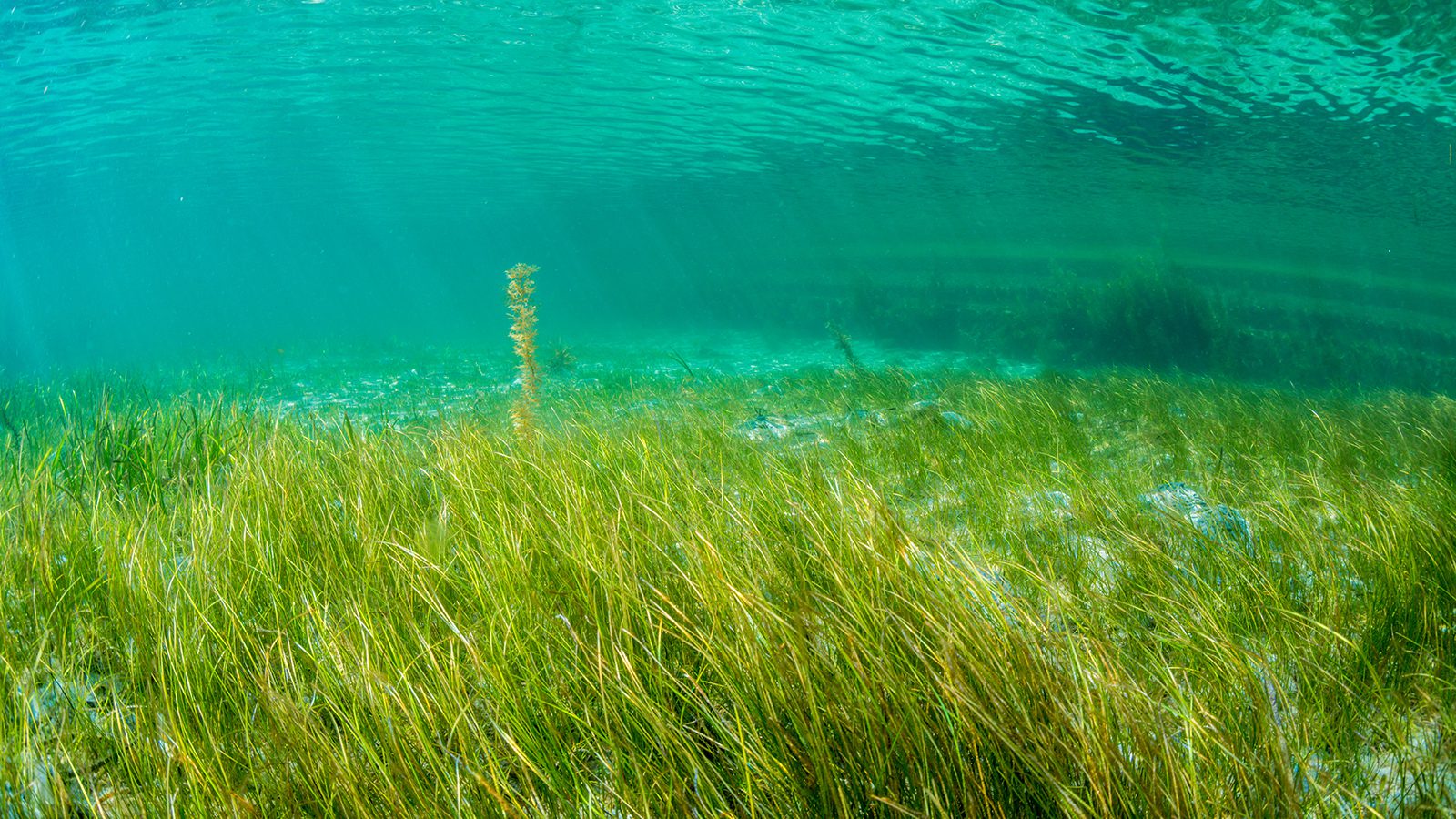According to marine scientist Carlos M. Duarte, the ocean harbors an unlikely ally in the fight against climate change: seagrass. Seagrasses evolved from terrestrial plants about 100 million years ago, which explains why marine meadows resemble grass on land.
While seagrasses account for only 0.1% of the seafloor, they remove about 33% of carbon in the seafloor each year. In total, seagrass meadows store over 10% of carbon in the oceans globally. Even more amazingly, they can absorb carbon up to 35x faster than Amazonian rainforests!
As climate change ramps up, this news couldn’t come at a more opportune time. While Duarte has studied seagrasses for nearly forty years, he only recently discovered their hidden power. Found in every continent except Antarctica, they’ve adapted over millions of years to colonize the ocean. About 50-60 different species of aquatic grasses exist worldwide, growing in shallow coastal waters where sunlight can easily penetrate.
As one of only 17 flowering plants to grow in marine environments, they’re a resilient, unique species indeed. Seagrasses populate by extending a rhizome – an underground stem that grows horizontally from 1cm to nearly five meters per year. Then, these networks of plant roots keep branching out along the seafloor to form large clones.
These clones can grow to massive sizes; Duarte discovered a clone in the Mediterranean that measured about 15 kilometers. This size equates to roughly the size of Manhattan! Even more remarkably, his team found that the clone originated from a seed that germinated 200,000 years ago.
Since it’s one of the oldest living organisms on the planet, UNESCO listed the seagrass meadow as a World Heritage Marine site. This fact means it’s protected from fishing or any other commercial activities. The mega clone meadow spans about 800 square kilometers and supports incredible biodiversity.
Marine Scientist Explains How Seagrass Can Help Fight Climate Change
Perhaps most importantly, Duarte’s team found that just one hectare of seagrass can sequester a massive amount of carbon. Shockingly, this relatively small area can store as much carbon as fifteen hectares of the Amazonian rainforest.
Of course, Duarte wanted to find out how the underwater plant could accomplish this monumental task. He discovered that since the plants have large canopies, they form an intricate web that filters out particles in the water. These particles settle in the seafloor and decompose slowly since seagrass soils don’t have oxygen. Carbon from decaying material then accumulates in the ground.
Also, seagrass meadows that grow in marine environments give them an advantage over forests. During forest fires, carbon in the soil returns to the atmosphere, contributing to a warming climate. However, since no fires occur underwater, the carbon in seagrass soils can remain safe for thousands of years.
When seagrasses grow, they raise the seafloor anywhere from 1 to 4mm per year. Over hundreds of years, they form reefs such as the extensive four-meter-tall meadow found in the Mediterranean. Duarte’s team even discovered a seagrass reef measuring 12 meters tall, which could hold an astonishing amount of carbon. Aside from sequestering carbon, seagrass offers another shield against climate change: protecting shorelines. Since climate change is already causing stronger hurricanes and rising sea levels, seagrass is crucial in defending infrastructure and property along the coast.
Finally, since seagrasses are flowering plants, they have seeds that humans can consume as marine rice. This crop doesn’t require arable land, water, fertilizers, herbicides, or pesticides, making it a sustainable food choice. Perhaps seagrass meadows could provide an answer to growing food insecurity around the globe shortly.
Seagrass Meadows Have Made a Comeback in the Last Century
Luckily, marine science and biology experts discovered the importance of seagrass just in time. As they learned about how it could fight climate change, they became aware of its vulnerability.
In the 1930s, a disease killed large areas of seagrass in the Atlantic. As it began to make a comeback, sewage and agricultural runoff wiped out these meadows worldwide. Anchors from large ships, trawling and dredging of the seafloor, and other mechanical operations threatened the aquatic grasses.
These factors compounded by the end of the 20th century, killing one-third of seagrasses worldwide. In the last few decades, scientists realized the urgency in protecting this fragile underwater plant. However, they’re still trying to map all the seagrasses worldwide.
Estimating the Impact
They estimate that seagrasses occupy between 150,000 to one million square kilometers of the ocean floor. Unfortunately, satellites can’t differentiate seagrass from other types of the seafloor, making it challenging to confirm its distribution.
Luckily, the scientists found a solution: tracking green sea turtles and tiger sharks that feed on or swim near seagrasses using satellite devices. They’ve uncovered new seagrass meadows in the Indian Ocean and the Red Sea by monitoring the marine animals. Through this method, they also discovered the largest seagrass meadow in the world off the coast of the Bahamas.
Now that they’ve begun mapping the seagrasses, they’ve also taken steps to protect them. Due to their efforts, seagrasses have started to recover in Europe, North America, China, Australia, and Japan.
They’ve also released millions of seeds to encourage new seagrass growth. In the early 2000s, Duarte’s colleagues released 7.5 million seeds in South Bay, along the coast of Virginia. Sixteen years later, the area measured 20 square kilometers; today, it’s grown to 36 square kilometers. This meadow sequestered so much carbon that Virginia passed a bill on seagrass restoration.
After researching seagrass’ impact on climate change and watching the meadows blossom back to life, Duarte feels confident we can restore our oceans. His team published a paper in the journal Nature last year that suggested it’s possible to “rebuild” ocean biodiversity by 2050. Ensuring the health of our oceans will bring us one step closer to stabilizing the climate.
Final Thoughts on the Importance of Seagrass in Tackling the Climate Crisis
When you hear about carbon sequestration, it’s mostly confined to reforestation or geoengineering techniques. However, meadows have started coming into the spotlight recently because they store carbon effectively. Also, these meadows can protect shorelines from devastating hurricanes and cyclones and even provide food with their seeds. As we face mounting ecological challenges, seagrasses may play a pivotal role in helping us overcome them.
















 Community
Community

